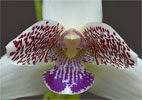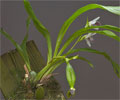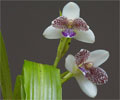|
|
|
|
 |
Email Address Recovery or Password Reset |
Use our Change Password page, and you can set a new password, or if you don't remember which email address you
registered with, the same page may be able to suggest it based on another you enter.
|
|
|
|
|
| |
Flasks of
Pabstia jugosa 'MC6526' × self |
|
| |
|
|
| |
| Number: |
TN7698 |
| Name: |
Pabstia jugosa 'MC6526' × self
|
| Type: |
self (What's that?) |
|
Seed Donor: |
Dale Borders
|
|
Click to Enlarge

Pod Parent Flower |
Click to Enlarge

Pod Parent Blooming Plant with Capsule |
Click to Enlarge

Pod Parent Flowers |
|
|
|
| |
For additional origin/habitat information supplied courtesy of
Charles and Margaret Baker, see further below, near the bottom of this page.
|
Temperatures we attempt to use in the lab & greenhouse:
| For Species: |
|
Spring, Summer, Autumn: days average 76°F, nights 63°F; best fit is cool-intermediate 75-58°F
(Source:
Baker's Web OSC) |
| For Species: |
|
Winter: days average 66°F, nights 54°F; best fit is Cool 70-52°F
(Source:
Baker's Web OSC) |
|
About the name...
| Etymology of |
jugosa |
|
From Latin "jugosus" yoke-like, saddle-shaped.
(Source:
Mayr & Schmucker 1998) |
| Etymology of |
Pabstia |
|
Named for Guido Pabst. Director of Herbarium Braedeánum in Rio de Janiero, Brazil, described numerous Brazilian orchids during the 20th century.
(Source:
Mayr & Schmucker 1998) |
| Pronunciation of |
jugosa |
|
joo-GOE-sa
(Source:
Hawkes 1978) |
| Pronunciation of |
Pabstia |
|
PAB-sti-ah
(Source:
Mayr & Schmucker 1998) |
|
If you would like to direct someone to this web page, please copy and paste this URL into your email:
http://troymeyers.com/d?017698
| Flask Information |
| Availability: |
We have sold all of the flasks for this item. |
| You should: |
Consider getting individual plants or compots instead of a flask.
You can place a "Notify Flask Recipients" Request, and either we or a flask recipient may contact you when plants are available.
You may also place a "Notify Retries" Request, and if an identical pollination (the same parents) is done again, we'll let you know.
You may reserve a flask, but it's very unlikely you'll get one ...this could only happen if we found a flask that we didn't know we had. |
| Yield Estimate: |
76 plants (based on flask surveys done 06/10/2014 through 07/08/2016)
|
| Plantlet Sizes: |
From many flasks 15 - 80 mm plants (based on flask surveys done 07/29/2015 through 07/08/2016)
From one most recently surveyed flask 15 - 80 mm (07/08/2016)
|
|
You might also want to:
|
View the seed assay for this item.
View items of the same species.
View items of the same genus.
|
| Ordering Information |
| You are not currently logged in. |
|
You must be a registered user and be logged in to reserve a flask or place a notification request. Please log in:
|
|
 |
Email Address Recovery or Password Reset |
Use our Change Password page, and you can set a new password, or if you don't remember which email address you
registered with, the same page may be able to suggest it based on another you enter.
|
|
|
|
|
|
|
|
| |
The origin/habitat information below is supplied courtesy of Charles and Margaret Baker
The following information is based on the name of the plant provided by the donor, and assumes that the name is correct. If the plant has been misidentified, then the following information may not be correct.
This text is copyrighted by the Bakers and may not be reproduced without permission.
ORIGIN/HABITAT: Brazil. This endemic orchid was found originally near
Petropolis, but it is now known to occur in many areas in the cool coastal
mountains between Rio de Janeiro and Sao Paulo, usually at 2000–4500 ft.
(610–1370 m). In the humid, moist, cloudforest habitat most surfaces are
covered in moss several centimeters long, and Pabstia jusosa grows on
moss-covered trees and rocks. Sophronitis coccinea, Promenaea xanthina,
Scuticaria hadwenii, Maxillaria punctata, and Oncidium gardnerii are also
found in the same region.
More about this information and the Bakers...
|
|
|
| |
|
|
|